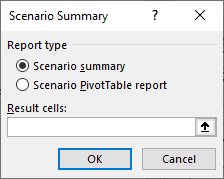Please Note: This article is written for users of the following Microsoft Excel versions: 2007, 2010, 2013, 2016, 2019, and 2021. If you are using an earlier version (Excel 2003 or earlier), this tip may not work for you. For a version of this tip written specifically for earlier versions of Excel, click here: Creating Scenario Summaries.
Written by Allen Wyatt (last updated August 1, 2023)
This tip applies to Excel 2007, 2010, 2013, 2016, 2019, and 2021
If you have a number of different scenarios devised for a worksheet, you can quickly create scenario summaries. These list the values in each of your scenarios, along with any result cells you want to show. They are very helpful for providing an overview of the different scenarios.
To create a summary, all you need to do is follow these steps:

Figure 1. The Scenario Summary dialog box.
Even though the report is fully formatted, you can make formatting changes as you deem appropriate. You will probably want to do this anyway, since Excel uses cell addresses for cells that aren't named. Make your changes and then save your workbook as you normally would.
ExcelTips is your source for cost-effective Microsoft Excel training. This tip (8570) applies to Microsoft Excel 2007, 2010, 2013, 2016, 2019, and 2021. You can find a version of this tip for the older menu interface of Excel here: Creating Scenario Summaries.

Professional Development Guidance! Four world-class developers offer start-to-finish guidance for building powerful, robust, and secure applications with Excel. The authors show how to consistently make the right design decisions and make the most of Excel's powerful features. Check out Professional Excel Development today!
When you create and save scenarios in a workbook, you can later pull them out and display them. Here's how to do it.
Discover MoreOnce a scenario is defined and saved, you can later revisit the values you created for the scenario and modify them. ...
Discover MoreExcel allows you to create different scenarios for the data in your worksheet. These can be saved and managed using the ...
Discover MoreFREE SERVICE: Get tips like this every week in ExcelTips, a free productivity newsletter. Enter your address and click "Subscribe."
There are currently no comments for this tip. (Be the first to leave your comment—just use the simple form above!)
Got a version of Excel that uses the ribbon interface (Excel 2007 or later)? This site is for you! If you use an earlier version of Excel, visit our ExcelTips site focusing on the menu interface.
FREE SERVICE: Get tips like this every week in ExcelTips, a free productivity newsletter. Enter your address and click "Subscribe."
Copyright © 2026 Sharon Parq Associates, Inc.
Comments